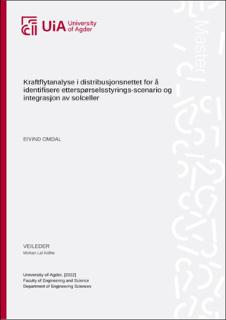| dc.description.abstract | Electrification, more power-intensive technological equipment, and an exponential increase in
photovoltaic systems on transformer circuits lead to changes in the load patterns of end customers.
The master's thesis investigates whether the new NETBAS module can increase the precision of the
grid calculations, where the module makes grid calculations based on actual measured values with
hourly resolution from the AMS electricity meters. The new NETBAS module makes it easier to map
where there are actually deviations in the grid and how much Velander's formula deviates from
measured hourly values. The benefits of the new NETBAS module are demonstrated through three
transformer circuits. One of the circuits has voltage challenges related to under voltages, and two of
the circuits have existing prosumers connected. The transformer circuits are simulated through
different degrees of penetration of photovoltaic systems and new customers connected to the
transformer.
Velander's formula over- and underestimates the load on the transformer in winter and summer
compared with the hourly module, respectively. This is due to Velander's formula daily and annual
variations that do not correspond to end customers' current energy consumption patterns. On the
other hand, Velander's formula simulates voltage values closer to measured voltage values than the
hourly module. This can be explained by MAPE, where the transformer voltage with Velanders
formula and the hourly module differs by 1.58 to 3.34% and 1.16 to 3.18% compared with measured
voltage values, respectively. Since Velander's formula calculates a generally higher load on the
transformer circuit, which results in a higher voltage drop to the end customers and voltage values
closer to measured voltage values. The hourly module shows far greater precision in the calculations
where transformer circuits have existing prosumers connected. This is because photovoltaic systems
do not necessarily produce the plant's installed photovoltaic power. In contrast, a 12 kW and 14 kW
photovoltaic system produces 7.4 kWh and 2.75 kWh at maximum on the day with the lowest load,
respectively. Therefore, the hourly module will significantly improve the voltage calculations where
the transformer circuits have existing prosumers connected.
The master’s thesis shows that the hourly module has the potential to simulate with greater
precisions in the grid calculations and will have substantial utility values on transformer circuits with
existing prosumers. Although, the hourly module has several improvement points. The module
should load actual voltage values from the transformer, have an opportunity to simulate with fiveminute values that increase the precision, an opportunity to export graphs to other analysis tools,
and update the solar cell production graph that matches the solar conditions in Agder. The NETBAS
module should be updated with some of the additional features before Agder Energi Nett makes
investments in the module. | |
